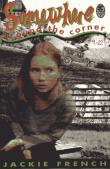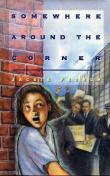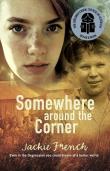AustLit
The material on this page is available to AustLit subscribers. If you are a subscriber or are from a subscribing organisation, please log in to gain full access. To explore options for subscribing to this unique teaching, research, and publishing resource for Australian culture and storytelling, please contact us or find out more.
Latest Issues
AbstractHistoryArchive Description
While participating in a political demonstration, a young Australian girl finds herself transported back in time to a homeless camp during the Depression where she discovers that the actions of one person can make a difference.
Notes
-
Study notes and educational kit available.
Publication Details of Only Known VersionEarliest 2 Known Versions of
Other Formats
- Also braille, sound recording and large print.
Works about this Work
-
Slipping back through Time : Discovering Time-Slip Fiction
2012
single work
criticism
— Appears in: Magpies : Talking about Books for Children , May vol. 27 no. 2 2012; (p. 8-11) -
y
 Re-Visiting Historical Fiction for Young Readers : The Past through Modern Eyes
New York (City)
:
Routledge Taylor & Francis Group
,
2011
Z1886683
2011
single work
criticism
'This study is concerned with how readers are positioned to interpret the past in historical fiction for children and young adults. Looking at literature published within the last thirty to forty years, Wilson identifies and explores a prevalent trend for re-visioning and rewriting the past according to modern social and political ideological assumptions. Fiction within this genre, while concerned with the past at the level of content, is additionally concerned with present views of that historical past because of the future to which it is moving. Specific areas of discussion include the identification of a new sub-genre: Living history fiction, stories of Joan of Arc, historical fiction featuring agentic females, the very popular Scholastic Press historical journal series, fictions of war, and historical fiction featuring multicultural discourses.
Re-Visiting Historical Fiction for Young Readers : The Past through Modern Eyes
New York (City)
:
Routledge Taylor & Francis Group
,
2011
Z1886683
2011
single work
criticism
'This study is concerned with how readers are positioned to interpret the past in historical fiction for children and young adults. Looking at literature published within the last thirty to forty years, Wilson identifies and explores a prevalent trend for re-visioning and rewriting the past according to modern social and political ideological assumptions. Fiction within this genre, while concerned with the past at the level of content, is additionally concerned with present views of that historical past because of the future to which it is moving. Specific areas of discussion include the identification of a new sub-genre: Living history fiction, stories of Joan of Arc, historical fiction featuring agentic females, the very popular Scholastic Press historical journal series, fictions of war, and historical fiction featuring multicultural discourses.
Wilson observes specific traits in historical fiction written for children — most notably how the notion of positive progress into the future is nuanced differently in this literature in which the concept of progress from the past is inextricably linked to the protagonist's potential for agency and the realization of subjectivity. The genre consistently manifests a concern with identity construction that in turn informs and influences how a metanarrative of positive progress is played out. This book engages in a discussion of the functionality of the past within the genre and offers an interpretative frame for the sifting out of the present from the past in historical fiction for young readers.' (Publisher's blurb)
-
Living History Fiction
2010
single work
criticism
— Appears in: Papers : Explorations into Children's Literature , vol. 20 no. 1 2010; (p. 77-86) 'During my research into historical fiction for children and young adult readers I came across a range of texts that relied on a living or lived experience of history to frame the historical story. These novels were similar to the time-slip narrative; however, not all examples used the traditional convention of time-slippage. I wanted to bundle these novels together - 'time-slip' novels included - as examples of 'living history' narratives because they appeared from the outset as a distinct literary form requiring particular reading strategies.
These texts, which I will refer to as Living history novels, require readers to align uncritically with modern perception. Readers are persuasively invited to assume that the modern characters' perception of the past is authentic because it has been formed by a lived experience of history. In Living history novels, readers are positioned to perceive both the strengths and weaknesses of past and present times, ultimately reconciling the two in a present that faces chronologically forwards. Modern focalising characters in Living history fiction place modern perception in a superior relationship to that of the past.
This sub-genre of historical novels is distinctive in its strong and consistent modern character focalisation and point of view. The Living history novel creates a confluence of past and present, be it physically or psychically. Characters are variously conveyed from a generalised present, or past, to an explicit historical period or event. The Living history novel is distinctive in its intense character introversion, quest journey and self-discovery. The most important outcome of the living history experience is that characters learn something significant about themselves. Because the story is about the modern character's quest and self realisation, the past is consistently perceived from their point of view. Modern characters are transported in time and readers are only rarely invited to see the past from a past point of view' (Author's abstract). -
Historical Novels by Jackie French
2004
single work
column
— Appears in: Classroom , vol. 24 no. 3 2004; (p. 21-22) -
Children's Book Council of Australia Annual Awards 1995 : Judges' Report
1995
single work
criticism
— Appears in: Reading Time : The Journal of the Children's Book Council of Australia , August vol. 39 no. 3 1995; (p. 2-10)
-
[Review] Somewhere Around the Corner
1994
single work
review
— Appears in: Reading Time : The Journal of the Children's Book Council of Australia , August vol. 38 no. 3 1994; (p. 37)
— Review of Somewhere Around the Corner 1994 single work children's fiction -
[Review] Somewhere Around the Corner
1994
single work
review
— Appears in: Magpies : Talking About Books for Children , November vol. 9 no. 5 1994; (p. 28)
— Review of Somewhere Around the Corner 1994 single work children's fiction -
[Review] Somewhere Around the Corner
1994
single work
review
— Appears in: Fiction Focus : New Titles for Teenagers , vol. 8 no. 2 1994; (p. 16)
— Review of Somewhere Around the Corner 1994 single work children's fiction -
Ten Little Australians for Middle-Aged Children
1995
single work
review
— Appears in: Australian Women's Book Review , November vol. 7 no. 3-4 1995; (p. 10-11)
— Review of Foxspell 1994 single work novel ; The White Guinea-Pig 1994 single work novel ; Somewhere Around the Corner 1994 single work children's fiction ; Jake and Pete 1995 selected work children's fiction ; Way Home 1994 single work picture book ; Featherbys 1993 single work novel ; A Bit of a Hitch 1995 selected work children's fiction ; The Magic Caravan 1995 single work children's fiction ; Ark in the Park 1994 single work children's fiction ; Power and Glory 1994 single work picture book ; The White Guinea-Pig 1994 single work novel -
Fine Descriptive Prose
1994
single work
review
— Appears in: The Canberra Times , 19 November 1994; (p. C11)
— Review of Somewhere Around the Corner 1994 single work children's fiction ; Reckless Rhymes 1994 selected work poetry -
Historical Novels by Jackie French
2004
single work
column
— Appears in: Classroom , vol. 24 no. 3 2004; (p. 21-22) -
Living History Fiction
2010
single work
criticism
— Appears in: Papers : Explorations into Children's Literature , vol. 20 no. 1 2010; (p. 77-86) 'During my research into historical fiction for children and young adult readers I came across a range of texts that relied on a living or lived experience of history to frame the historical story. These novels were similar to the time-slip narrative; however, not all examples used the traditional convention of time-slippage. I wanted to bundle these novels together - 'time-slip' novels included - as examples of 'living history' narratives because they appeared from the outset as a distinct literary form requiring particular reading strategies.
These texts, which I will refer to as Living history novels, require readers to align uncritically with modern perception. Readers are persuasively invited to assume that the modern characters' perception of the past is authentic because it has been formed by a lived experience of history. In Living history novels, readers are positioned to perceive both the strengths and weaknesses of past and present times, ultimately reconciling the two in a present that faces chronologically forwards. Modern focalising characters in Living history fiction place modern perception in a superior relationship to that of the past.
This sub-genre of historical novels is distinctive in its strong and consistent modern character focalisation and point of view. The Living history novel creates a confluence of past and present, be it physically or psychically. Characters are variously conveyed from a generalised present, or past, to an explicit historical period or event. The Living history novel is distinctive in its intense character introversion, quest journey and self-discovery. The most important outcome of the living history experience is that characters learn something significant about themselves. Because the story is about the modern character's quest and self realisation, the past is consistently perceived from their point of view. Modern characters are transported in time and readers are only rarely invited to see the past from a past point of view' (Author's abstract). -
Slipping back through Time : Discovering Time-Slip Fiction
2012
single work
criticism
— Appears in: Magpies : Talking about Books for Children , May vol. 27 no. 2 2012; (p. 8-11) -
Canberra Writers in Running for Awards
1995
single work
criticism
biography
— Appears in: The Canberra Times , 25 April 1995; (p. 4) -
Children's Book Council of Australia Annual Awards 1995 : Judges' Report
1995
single work
criticism
— Appears in: Reading Time : The Journal of the Children's Book Council of Australia , August vol. 39 no. 3 1995; (p. 2-10)
Awards
Last amended 25 Oct 2017 15:53:30
Settings:
- New South Wales,
- 1990s
- 1930s
Export this record





